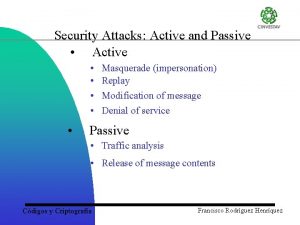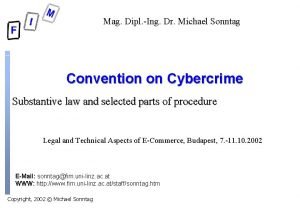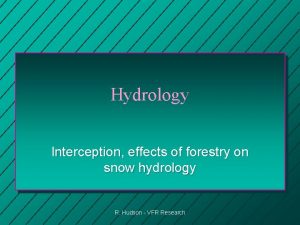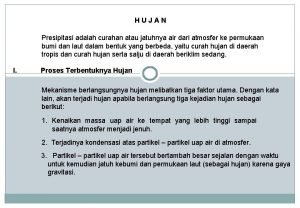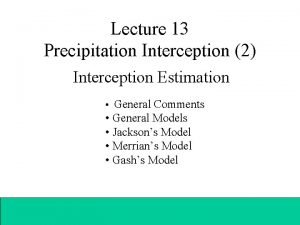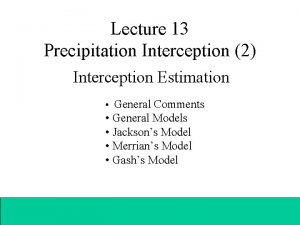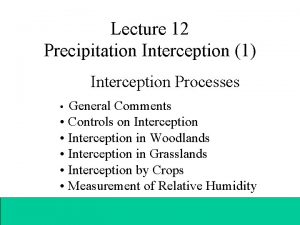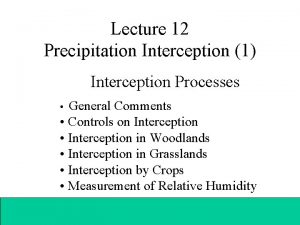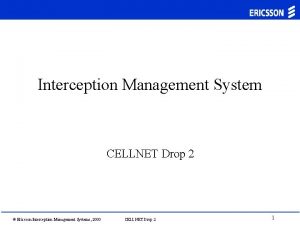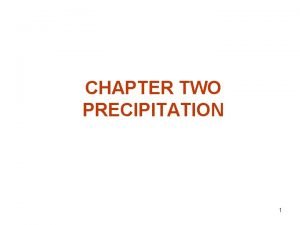Lecture 13 Precipitation Interception 2 Interception Estimation General










- Slides: 10

Lecture 13 Precipitation Interception (2) Interception Estimation • General Comments • General Models • Horton’s Model • Merrian’s Model • Jackson’s Model • Gash’s Model

General Comments • Models are generally simpler than measurements • Many models are developed with different assumptions and for different applications

General Model Interception water loss equals precipitation less throughfall (TF) and stemflow (SF) I = P – TF – SF I P TF SF = = Interception Precipitation above vegetation canopy Throughfall Stemflow

Empirical Models Interception loss can also be modelled as a linear function of precipitation: I I = a. P + b b P I P a b = = Interception loss Gross rainfall Slope (empirical coefficient) Intercept (empirical coefficient)

Relationship between rainfall and interception

Empirical Models (Jackson, 1975) It is a semi-empirical logarithmic model: I a P I P T a, b, c = = Interception loss Average rate of rainfall during event Duration of event Empirical coefficients I a ln. P

Interception model of Horton (1919) Interception loss equals the combined losses from: Intercepted water during precipitation event Intercepted water in canopy storage (evaporated later) I t S E = = Interception loss Duration of rainfall Interception storage capacity Rate of evaporation of intercepted water

Interception model of Horton (1919) (Modified) Horton’s model has been improved with the following model: I t t’ S E = = = Interception loss Duration of precipitation Time until canopy saturation Interception storage capacity Rate of evaporation of intercepted water

Merriam (1960) Used an exponential equation that considered diminished interception storage with increasing precipitation S time I S P E T = = = Interception loss Interception storage capacity Gross precipitation Average evaporation rate during event Duration of precipitation event

Gash model (1979) • A storm-by-storm accounting of interception loss • Most widely used model to date • Relies on several simplifying assumptions: (1) Rainfall represented by discrete storms and drying periods (2) Meteorological conditions constant during storms and canopy wetting (3) No drip from canopy during wetting (4) Canopy storage is perfectly saturated shortly after precipitation event Should read Chapter 3. 6 to understand the principles (no need to memorize the equations)
 Co precipitation and post precipitation
Co precipitation and post precipitation Co precipitation and post precipitation
Co precipitation and post precipitation 01:640:244 lecture notes - lecture 15: plat, idah, farad
01:640:244 lecture notes - lecture 15: plat, idah, farad Interception is an attack on
Interception is an attack on Interception fabrication modification interruption
Interception fabrication modification interruption Threats posed to networks
Threats posed to networks Dr michael sonntag
Dr michael sonntag Lawful intercept cisco
Lawful intercept cisco Sms interception hack
Sms interception hack Interception hydrology
Interception hydrology Hujan
Hujan




